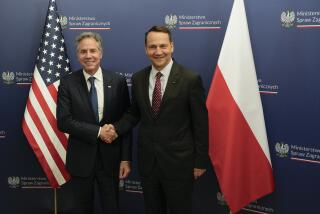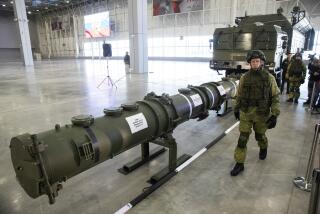Soviets Urge New Round of Arms Talks : Nuclear arsenals: Bessmertnykh calls for further reductions in strategic weapons. But Fitzwater says the move is ‘premature.’
- Share via
MOSCOW — On the eve of the solemn signing of a treaty to slash the superpowers’ nuclear arsenals, the Soviet Union pressed the United States on Tuesday to seek new arms control agreements in such major categories as strategic missiles, naval armaments and weapons in space.
“The business is not finished,” Soviet Foreign Minister Alexander A. Bessmertnykh told reporters. “We are somewhere in the middle. . . . We believe that we should immediately go into another consultation, and negotiations on further reduction of strategic armaments.”
But the areas in which Moscow wants to press ahead pose knotty problems for the Bush Administration, and the White House indicated that the United States is in no hurry for more negotiations. Presidential spokesman Marlin Fitzwater said it is “premature” to consider any specific new arms pacts.
Thus, even as they prepared to sign the landmark Strategic Arms Reduction Treaty to cut their nuclear weaponry by an estimated 30%, the two superpowers were at polite loggerheads on where to go next.
“We are interested in pursuing the arms control agenda,” said Fitzwater, but he added that the Administration wants first to “take stock of exactly where we are.”
His caution echoed that of Bush, who said before arriving here: “There won’t be any bold, new proposals on the part of the United States for a dramatic next step.”
Bush and Soviet President Mikhail S. Gorbachev were scheduled to discuss the future of arms control in their meetings today, before they sign the 750-page START accord that caps nine years of negotiations.
Gorbachev’s spokesman, Vitaly N. Ignatenko, listed a series of areas that Gorbachev would bring up, mirroring longstanding Soviet arms control concerns: Weapons in space, tactical nuclear weapons in Europe, sea-based nuclear arms and chemical weapons. “These are the basic problems that will be covered by our two presidents,” he said.
Bessmertnykh, speaking to reporters shortly before a meeting with Secretary of State James A. Baker III, put more emphasis on the Soviet desire for deeper cuts in long-range nuclear missiles and bombers, the weapons that are covered by the START accord.
“Maybe it will be somewhat easier because we have established the cornerstones of the negotiations,” he said, referring to START.
Bessmertnykh appeared to be taking up a suggestion made by some U.S. arms control experts--that the two countries take the START agreement and simply amend it to call for deeper cuts. The pact will restrict each side to 4,900 ballistic missile warheads and puts a variety of limits on bombers, air-launched cruise missiles and other weapons.
But Bush Administration officials have been skeptical of that approach. “Cuts for the sake of cuts is not good arms control,” one senior aide said last week.
Meanwhile, the Soviet foreign minister also warned, gently, that his government remains opposed to the U.S. Strategic Defense Initiative--the program to devise weapons that can shoot down nuclear missiles--even though the Bush Administration has scaled the plans back from those initially proposed by President Ronald Reagan.
Bush aides have said the President hopes to sell Gorbachev today on his proposal for a small SDI system designed to foil a small-scale missile attack, whether from an accidental launch or a rogue nation such as Iraq.
But Bessmertnykh said the Soviet Union still insists on strict compliance with the 1972 Anti-Ballistic Missile Treaty, which limits each country to a single site for antimissile defenses. The Bush plan calls for several sites, although some members of Congress have proposed a single-site program.
“The ABM Treaty is a sacred cow of arms control, and we should be careful of it,” Bessmertnykh said. At the same time, he added, “We shall be prepared to listen (to the U.S. ideas). . . . We shall look into the relationship between all these new programs and the ABM Treaty and how they can go together.”
More to Read
Sign up for Essential California
The most important California stories and recommendations in your inbox every morning.
You may occasionally receive promotional content from the Los Angeles Times.











